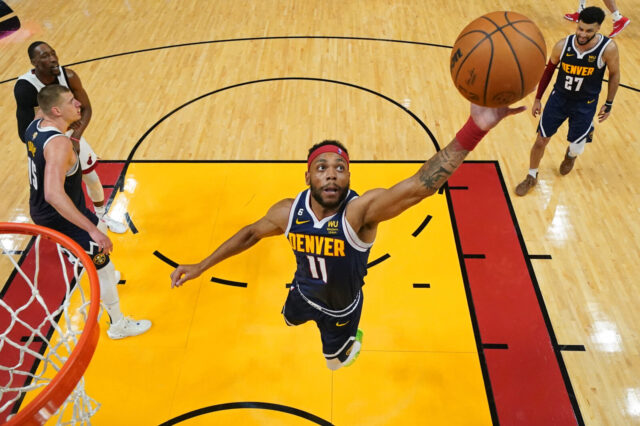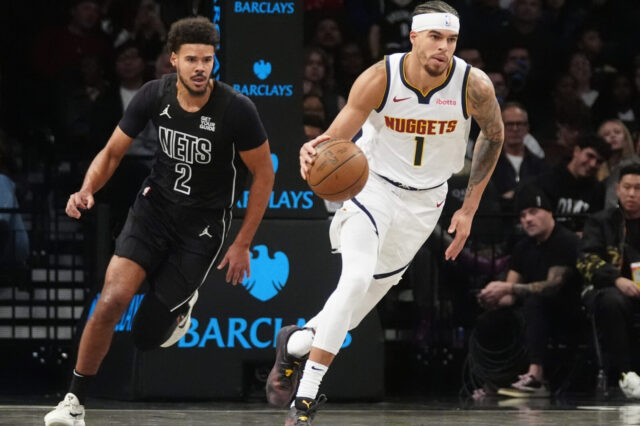Screen the screener (STS) is an action that shows up several times in every team’s playbook. The basic idea of any STS action is to use a defenses tendencies against them. A defender has a certain set of responsibilities when defending the screener and another set of responsibilities when defending the player being screened. STS forces that same defender to cover two actions at once.
First option: Jamal Murray for 3
The play is pretty simple when Denver gets their first option. Jamal Murray reverses the ball before setting a screen for a wing in the corner, usually for someone big enough to discourage the defense from switching. Wilson Chandler was the go-to option for this spot last season since he had the size to post up most opposing point guards. Will Barton and Torrey Craig also found themselves in that spot quite often last year but defenses are much more likely to switch screens between Murray and Barton since there isn’t a huge size gap between the two.
The angle of Murray’s screen is important here. I’ve written about Murray’s sneaky good screen setting before and even used an example of this play to highlight how well he finds the proper angles. On this play, he’s aiming to set the screen in-between the defender and the ball in a way that influences the defender to take the furthest route around. If Murray senses Chandler is going to curl above the screen, he’ll shade the defender toward running around the screen and trailing the cutter. If Chandler short-cuts the screen (meaning if Chandler rejects the screen and goes along the baseline), then Murray will try to force him over the top.
This is important because for a defense that doesn’t want to switch this play, a proper screen will get Murray’s man to “show” on the cut, allowing Murray an extra second to release above the break for a three-pointer. As Murray releases out above the break, the trailing big man hunts for Murray’s man to set a down screen.
Against a switch
The play can still work well against a team that is willing to switch the initial 1-3 screen but the tiny details tend to change a little bit. Notice how the angle of Murray’s screen on James Harden is a bit higher than on the previous two examples. Since he knows that Harden is going to switch this screen he wants to position himself above Harden so that he has a half step advantage on him when he releases toward the wing.
From there, Murray is trying to read which way Harden will chose to fight over the screen. You can see how Murray initially plants his feet like he is going to curl toward the top of the key but then flares out toward the wing once he senses Harden is going to try to shoot the gap around Jokic. Jokic himself has to read both Harden and Murray and make the split-second decision on the angle to take to shade Harden the furthest away from Murray. Read it quickly enough and you get the play above. Read it too late and you’ll get called for an illegal screen, a call Harden lobbies at the official toward the end of this play.
Fake and go
Jamal Murray’s gravity as a catch-and-shoot threat makes this play especially difficult to guard, even when the defense is prepared to defend in. In both clips above, Murray’s defender is able to fight through the down screen and run him off of the three-point line. Murray’s footwork can make a big difference here. In the first clip, which was from a game on November 11th, his gather is a bit messier. He fails to square up and his first dribble doesn’t take him anywhere other than to re-balance his body. The second clip, taken from a game on March 27th, is a lot cleaner. If you look carefully you can see Kyle Lowry wind up to contest the shot, losing his balance in the process.
Another interesting detail is the spacing difference between Barton and Chandler. Barton cuts though to the block but then immediately spaces into the corner, putting his defender in a pick-your-poison type scenario. In the second clip, Chandler stays near the block where his man should’ve been able to help without giving up a good look.
2-man game on the roll
Poor Jusuf Nurkic. He actually does a nice job of playing in-between on this play. He’s in the paint early so that Murray has to pick up his dribble and make a decision before he gets too much momentum barreling toward the rim. This is exactly what your rim protector is supposed to do – force the offense to react to you. Unfortunately for him, Murray makes a perfect pass and Mason Plumlee takes the elevator one floor higher.
Murray curls short
If Murray feels that he hasn’t created any separation from his defender, he can curl the down screen before the three-point line like he does in the example above. It’s among the worst options since it all but forces Murray to commit to attacking the basket but it’s one read he can make if he feels there is an opening.
Blind pig
Here is where a team can really benefit from getting comfortable with a free flowing style of offense that transitions from a scripted play into an unscripted reaction. Defensive ace, JR Smith does a nice job of fighting through both screens to deny Murray the pass, ruining the script. Plumlee does a phenomenal job of acting as a release valve and flashing to receive the pass at the top of the key creating a great opportunity for a “blind pig” action.
The blind pig option was one of the staples of the triangle offense, where the big would flash and then throw an immediate pass for the guard or wing cutting toward the basket. A defender cannot guard a player in two opposite directions so if Smith is playing on the high side of Murray, Murray should be able to read that instantly and cut backdoor as soon as Plumlee receives the pass. Unfortunately, Plumlee’s brain was firing a bit quicker than Murray’s on this play and Murray elects instead to back it out. Opportunity missed.
STS into a re-screen
When the play doesn’t work to create an immediate shot, the best option is to flow right into a re-screen at the top of the key. In the clip above, watch how Kyrie Irving has to fight through three screens in the span of six seconds. Not only does that back-to-back-to-back nature of the screens exhaust a defender, it also causes three consecutive calculations for Irving and his teammates to make in quick succession. The result is that Aron Baynes shows for a split second too long and Jaylen Brown gets caught between helping in the paint and sticking to his man in the corner.
Side note: the slow developing play allows Chandler enough time to walk to the corner, an important detail for putting Brown in position to make a mistake. In the words of Lester Freeman, “all the pieces matter.”
Keeping the defense honest
90% of the time, this play will result in either a Murray three, some kind of Murray PnR, or it will evolve into a free-flowing possession. But that initial cut across the lane isn’t just for show. If a defense gets lazy, Denver’s bigs are more than capable of rifling in a pass for a quick post-up at the rim.
Double screen option
Perhaps my favorite wrinkle in this series. Here, rather than pass the ball to Murray above the break, Trey Lyles dribbles into a dribble handoff (DHO), adding an extra screen for Murray’s man to fight through. What’s even better is that everyone on Denver’s roster does a great job of reading the next step in the chain of events. Murray gets double-teamed so he quickly gives it up to Jokic who just as quickly hands it off to Murray once again. This forces Jason Terry to fight through four screens in six seconds while the rest of the defense scrambles to cover a ton of space in help side.
This example was from a game on April 1st and shows how much more comfortable a team can get with a specific play over the course of a season. In the clip above, everyone is reading and reacting in perfect harmony for 18 seconds of the shot clock, resulting in a wide open catch-and-shoot three. Lyles reads the handoff and then does a great job of exiting toward the corner. Jokic does a great job of reading a DHO opportunity. Torrey Craig cuts toward the basket before realizing he’s better used spacing the floor. And Juancho Hernangomez reads exactly where to slide in order to put as much distance between himself and his defender who was forced to rotate toward the corner for help.


